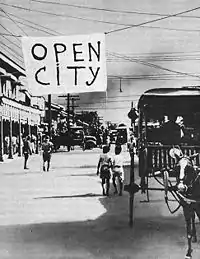不設防城市
戰爭期間,如果一個城市快將被奪取,控制該地的政府或者軍事組織可能會宣告該城為不設防之城市(Open City),亦即是該地自願放棄一切的抵抗力量。敵方軍隊被認為可能不會炮轟或攻擊該地,而只會以行軍形式進入該市,以免受到各界譴責。該共識的目的是希望保護當地歷史名勝和滯留的人民,避免不必要的戰役。

菲律賓戰役期間,馬尼拉被宣告為不設防城市。
宣告成為不設防之城市的一些例子:
- 1940年的布鲁塞尔,第二次世界大戰比利時戰役
- 1940年的巴黎,法國政府在明顯不能保衛它的情況下放棄它。
- 1941年4月的贝尔格莱德,由南斯拉夫王国在第二次世界大戰南斯拉夫戰役前宣布;然而德意志國防軍并未尊重这一决定,而是用空投炸弹血洗了这座城市;[1]
- 1942年的馬尼拉,道格拉斯·麦克阿瑟在不能抵抗日本軍隊的攻势時放棄它[2];在宣布不设防后,美军依然用这座城市进行后勤工作[3];日军无视了不设防的宣告,继续进行轰炸[4]。
- 1943年8月14日的羅馬市,防禦的意大利軍隊單方面宣告成為不設防之城市,避免了盟軍對其的轟炸。之後德軍攻擊時,該市仍是不設防之城市。隨後,盟軍在1944年7月進入羅馬,撤退的德軍亦宣佈佛羅倫斯和基耶蒂成為不設防城市。
- 1944年10月11日的雅典,德國宣佈成為不設防之城市。[5]
- 1945年5月3日,纳粹德国政府宣布汉堡为不设防城市,随后英國軍隊占领此城[6];
敵方軍隊並不一定尊重不設防城市的宣告。抵抗力量亦可能使用政治戰略。[7]另外控制當地的政府或會以此作為軍事防守策略之一。
參看
參考
- Petranović, Branko. [History of Yugoslavia 1918-1978]. Belgrade: Nolit. 1987: 184.
- . 芝加哥论坛报. 1941-12-26, C (309): 1.
- John W. Whitman. . Historynet. January 1998 [2021-06-15]. (原始内容存档于2021-06-15).
- . The New York Times. 28 December 1941, XCI (30,654): 1 [2021-06-15]. (原始内容存档于2019-06-07).
- . [2009-05-06]. (原始内容存档于2006-10-02).
- . The Morning Bulletin. 4 May 1945, (25,442): 1 [2021-06-15]. (原始内容存档于2019-12-13).
-
- Murphy, Paul I. and Arlington, R. Rene. (1983) La Popessa: The Controversial Biography of Sister Pasqualina, the Most Powerful Woman in Vatican History. New York: Warner Books Inc. ISBN 0-446-51258-3, p. 210
This article is issued from Wikipedia. The text is licensed under Creative Commons - Attribution - Sharealike. Additional terms may apply for the media files.